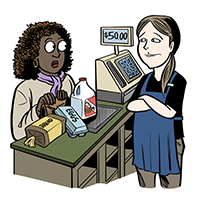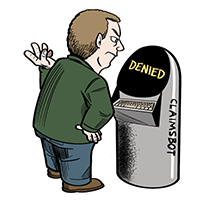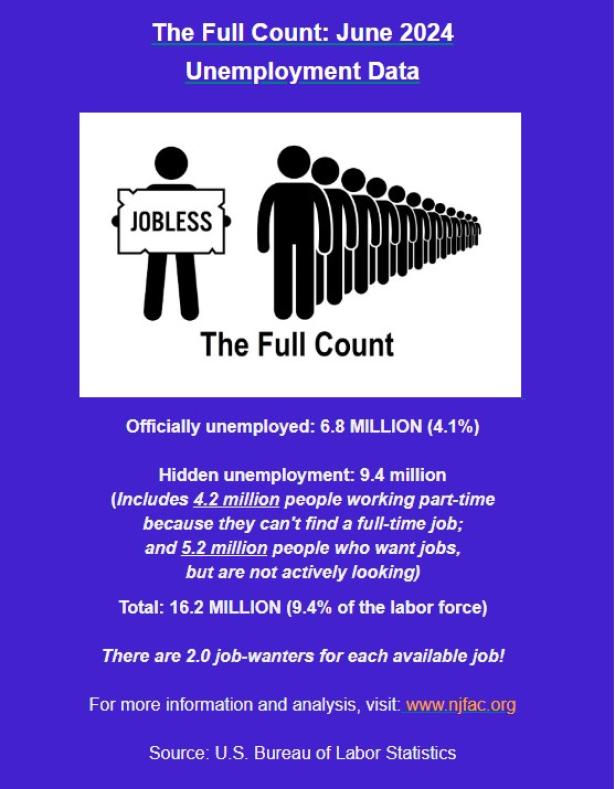The federal government generates millions of economic numbers in thousands of publications every year. Some of these publications can be useful for those of us who want to lift working-class living standards and build political support for shifting much more income to the working class and away from the ultra-rich households at the top of the income scale. But not all are as useful as they should be. I discuss and evaluate key publications in five areas. Much government information can be used to construct arguments for our side.
The Poverty Line: A Failed Number
Does the federal government regularly publish estimates of what a reasonably comfortable living standard would be for an average household? There must be something somewhere. A government agency does publish poverty lines--aka, poverty thresholds--and its experts tell us how many people fall below the lines. Each spring, the Census Bureau gathers income and other information on the preceding year and publishes the results in September. The last report was Poverty in the United States: 2022.

According to this publication the proportion of the population that was poor in 2022 was 11.5%. That is the poverty rate. There are rates for many categories, including ethnic groups and households with no workers. Recently the Census Bureau created Supplementary Poverty Measures (SPM) which offer more information than the official poverty rate. But the SPM poverty rate was just 12.4%, so it does not change the basics, and it has not motivated me to master the details of the SPM. The big picture for me is that each poverty measure is totally inadequate, especially in a country that is overflowing with riches. The poverty lines are given on page 18 of the 2022 report. The line for a family of four with two young children was $29,678. The line for singletons 65 or older was $14,036. Think about those numbers for half a minute. A family of four with $30,000 a year was not officially poor in 2022.
By this reckoning, a $15 an hour job for 2000 hours a year puts a family over the poverty line. And $25 an hour for 40 hours every single week is heaven: $52,000, before Social Security and other deductions. But we know that in reality, even that isn’t heaven for a family of four. We need new poverty lines that reflect economic realities, one of which is that living standards and the total wealth of the nation have zoomed upward since the lines were first developed in the 1960s. The necessities for a minimally average living standard have increased over the decades, and average real (after-inflation) incomes have increased substantially since the 60s. So the people labeled poor are ever more distant from the people in the middle of the income scale than they were in the early 1960s.
And the lines were very low to begin with. How did that happen? The official poverty lines were established in the 1960s, during the Kennedy and Johnson administrations. Michael Harrington and others wrote about poverty in the age of affluence. Meanwhile, a smart woman named Molly Orshansky, who had moved from the Department of Agriculture (DOA) to the Division of Research and Statistics in the Social Security Administration (SSA) in 1958, was creating low-income budgets and the beginnings of poverty lines. She used DOA model food budgets to construct dozens of poverty lines for families of different size and shape. It was believed that food expenditures for low-income households were a third of total budgets, so one could multiply DOA food budgets by three to get credible poverty lines. There were several lines for a family of four, but two that were under discussion in 1963 were quite low—even stingy: the low-income budget at $3,995 and the economy or emergency food budget at $3,165. SSA officials pushed for the higher one but in 1965 the Office of Economic Opportunity—the administration’s War on Poverty office—chose the emergency budget. And all federal agencies were ordered to use that one. Except for minor adjustments, and updating for price changes, that is still the basis of U.S. poverty lines.
Real Earnings Is Real Useful

More useful than current poverty lines is the Bureau of Labor Statistics (BLS) monthly report whose title is Real Earnings. This short publication covers all non-farm private-sector employees and includes a subset of information on production and non-supervisory workers, i.e., a more working-class group than that of all employees. In this publication you will find bar graphs and tables on changes in real pay—that is, with the effects of inflation removed. For example, in January of 2024 hourly pay checks looked like they had increased by 4.8% from January of 2023, but after inflation, the real purchasing power of the average wage grew by just 1.8%. Nothing to write home about.
In this publication you will find numbers on various aspects of earnings and a Consumer Price Index which shows many things, including that prices rose by 6.2% between January 2022 and January 2023, but only 2.9% the following year. However, if you want to do a lot of work with prices and on an array of items, you should use the monthly BLS publication called Consumer Price Index.
Labor Flows
An underused batch of statistics that provides a surprising conclusion has to do with labor flows. Where do most people who find jobs in a particular month come from? Well, they must have been “unemployed” in one month and employed in the next, right? Turns out that is not quite right. Of six million newly employed workers in January 2024, most of them were not searching for work in the previous month, that is, they were not taking at least one of what the BLS defines as active job-search efforts, such as contacting an employer about a job or seeking assistance from friends and relatives about job leads. So they weren’t “unemployed.”

In January 2024, of all newly employed persons only 1.3 million had been officially unemployed in December. But 4.7 million had not been in the labor force—i.e., neither working nor looking for work in approved ways, but they found jobs.
Why is this useful information? Because it gives support to the idea that the population of job-wanters is always much larger than the people who are actively searching for work. There are always millions of people out there who are essentially unemployed and who are on the lookout for good job opportunities but are not counted as unemployed. Many of them eventually find jobs.
To reiterate, the population of job-seekers is always much greater than the BLS’s unemployed population. It is closer to National Jobs for All Network’s (NJFAN) Full Count, which adds part-timers who want full-time work and people who say they want jobs but have not searched recently. Thus, when the official unemployment rate is 4% or 3.6%, we are not close to full employment, although many of our leaders and experts think we are.
To be fair, I must mention that BLS officials gave a nod to some of its critics and created a set of additional unemployment numbers. It appears as Table A-15 in the monthly Employment Situation and is labeled “Alternative Measures of Labor Underutilization.” It includes U-3, the official unemployment rate, and U-6, which adds to the official population of unemployed people who have to work part-time because they cannot find full-time work or have had their hours cut and people who were not searching for a job but were available for work and had searched for work in the last twelve months. In March, 2024, U-3 was 3.8% and U-6 was 7.3%. That is an improvement but it does not go far enough, NJFAN’s more realistic unemployment rate was 9.3%. And, by the way, neither the Bureau nor most commentators pay much attention to U-6.
Unemployment Claims as an Indicator?

One statistic that commentators and policy makers like to watch is the number and trend of weekly initial claims for unemployment benefits. Most of the time lately, initial claims have been on the low side—over 200,000 but below 250,000. The latest average for the four weeks ending April 6 was 214,250. In past years, the number has been higher, and, of course, during the pandemic, the numbers went through the roof. The number of officially unemployed workers jumped overnight to 21 million. In one week in April 2020, there were six million initial claims for unemployment benefits. And at one point, over 30,000,000 people were getting some kind of benefits, including regular unemployment benefits and special pandemic benefits, some of which went to gig workers who are outside the unemployment insurance system.
Normally, only about a third of those who are unemployed are getting benefits. Part of the explanation for why more are not getting aid is that some people think they are not eligible and don’t apply. Some are ineligible according to current rules. Others think they will find new jobs soon. Also, some people, including gig drivers in most states, are not considered employees, and so their employers do not pay into the Unemployment Insurance system.
FYI: The numbers on initial claims and ongoing benefits can be found in the Department of Labor’s weekly publication called Unemployment Insurance Weekly Claims. It appears every Thursday.
And Finally, The Employment Situation

The most important document on jobs and unemployment, the one the experts wait for every month, is the BLS report which this month appeared as The Employment Situation—March 2024. The report usually appears on the first Friday of the month. It runs about 40 pages and contains thousands of useful numbers on jobs and unemployment rates for dozens of groups. There are two numbers that experts and commentators are especially keen to know: the overall unemployment rate and the number of jobs added or subtracted by non-farm employers. In March, those employers added 303,000 jobs—a healthy number and more than some had predicted. Meanwhile, the unemployment rate fell a bit from 3.9% to 3.8%. In terms of the official unemployment rate, the last two years have been very good: the official unemployment rate has not once gone as high as 4%.
While things have been quite good by conventional standards, my colleagues and I in the National Jobs for All Network and many other people too believe that official unemployment rates substantially underestimate the size of the unemployment problem. Every month NJFAN publishes its Full Count, which uses federal data to construct a more realistic representation of the facts. We highlight rates for key groups such as Black Americans and disabled workers. We also create a more realistic unemployment rate by adding to the “officially” unemployed group these people: part-timers who want full-time work and people who say they want a job but have not searched recently. In the latter group are some who have looked for work in the past year but not recently. Some have not searched recently because of child-care responsibilities, disabilities, and pessimism about finding a decent job. While official unemployment in February was 3.8%, NJFAN’s Full Count was 9.3%. In other words, there was a lot of hidden unemployment.
ILLUSTRATIONS BY KEVIN MOORE
FRANK STRICKER is on the board of the National Jobs for All Network. He wrote Why America Lost the War on Poverty (2007) and American Unemployment: Past, Present, and Future (2020). He is emeritus professor of history and labor studies at Cal State University, Dominguez Hills.
KEVIN MOORE is a cartoonist and illustrator who has appeared in In These Times, The Nib, and elsewhere. His political fantasy webcomic Fetch posts weekly.
Dollars & Sense is a non-profit, non-hierarchical, collectively-run organization that publishes economic news and analysis, with the mission of explaining essential economic concepts by placing them in their real-world context. We publish a bi-monthly magazine, as well as economics books that are used in college social science courses, study groups and other educational settings. donating or subscribing.


Spread the word